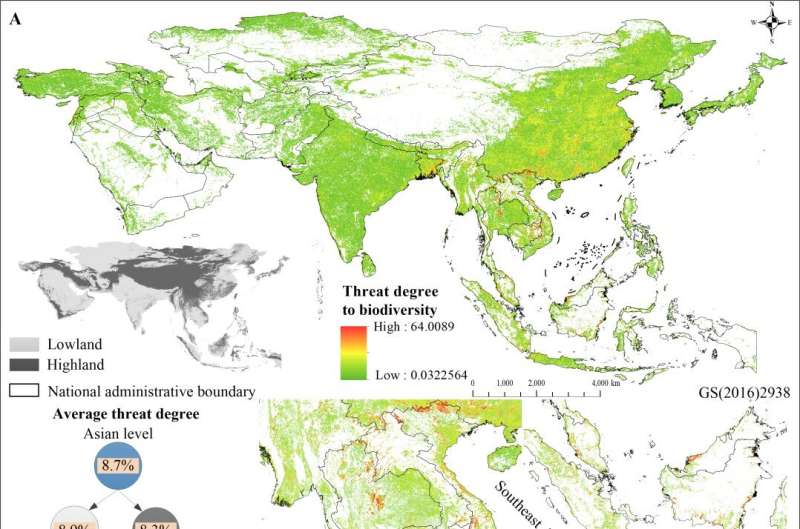This article has been reviewed according to Science X's editorial process and policies. Editors have highlighted the following attributes while ensuring the content's credibility:
fact-checked
peer-reviewed publication
proofread
Human expansion found to pose widespread threat to biodiversity in Asia, especially in Southeast Asia

Biodiversity is essential for sustaining food security, livelihood, ecosystem health, and economic development and for preventing future epidemics. Asia, with nearly 60% of the world's population, stands out as a priority for urgent biodiversity conservation due to its large threatened species and protected areas (PAs), and many countries globally are facing extreme biodiversity and ecological threats.
Satellite observations have shown that the human activities (i.e., cropland and artificial surface creations) in Asia have rapidly expanded since the 21st century and are being expanded to highlands (hilly and mountainous regions). Obviously, the intensification of human activities has induced widespread habitat losses and fragmentations and has subsequently threatened biodiversity.
Therefore, the comprehensive assessment of the threat degree of human expansion to biodiversity, especially the threat difference in lowland and highland developments, can provide a basis and new insight for biodiversity conservation and sustainable development. Unfortunately, the knowledge of threats of human expansions in lowlands and highlands to biodiversity remains unknown.
To address this conundrum, the research team from Shenzhen University (Chao Yang, Qingquan Li and their colleagues) has proposed a threat degree index (mainly integrating density maps of patch number, patch area, and number of threatened species involved in the patches of human expansions) to explore the threat degrees and differences of human expansions in highlands and lowlands to biodiversity at the continental (Asia), national (48 Asian countries) and hotspot (6,502 terrestrial PAs within Asia established before 2000) scales.
Their results show that human expansion poses widespread threat to biodiversity in Asia, especially in Southeast Asia, with Malaysia, Cambodia, and Vietnam having the largest threat degrees (∼1.5–1.7 times of the Asian average level). Human expansion in highlands induces higher threats to biodiversity than that in lowlands in one-third Asian countries (most Southeast Asian countries). Moreover, human expansion in highlands is more likely to pose a threat to biodiversity.
The regions with threats to biodiversity are present in ∼75% terrestrial PAs (including 4,866 PAs in 26 countries), and human expansion in PAs triggers higher threat degrees to biodiversity than that in non-PAs.
Their findings provide novel insight for the Sustainable Development Goal 15 (SDG-15 Life on Land) and suggest that human expansion in Southeast Asian countries and PAs might hinder the realization of SDG-15. To reduce the threat degree, authors call on all countries should strengthen their regulation of biodiversity.
Asian developing countries should accelerate economic transformation to reduce highland developments, especially in Southeast Asian countries. The developed countries in the world should reduce the demands of commodity trade (i.e., trade leading to the loss of wildlife habitats) from Southeast Asian countries to alleviate human expansion, especially in PAs and highlands.
The findings are published in the journal Research.
More information: Chao Yang et al, Human Expansion-Induced Biodiversity Crisis over Asia from 2000 to 2020, Research (2023). DOI: 10.34133/research.0226
Journal information: Research
Provided by Research




















